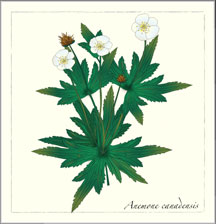Description: The name anemone is derived from the Greek word anemos which means wind, giving us the common name of windflower for many of the anemone species.Perennial with white flower with 5 petal-like sepals, 1 to 1 - 1/2" wide, with a yellow center. The flower sits upon a single, hairy stalk reaching heights up to 2 feet tall. The basal leaves are coarsely toothed and deeply divided into three narrow segments. As you progress up the stalk the leaves are equally  toothed and divided, however; they are stalkless and are whorled around the plant stem. This plant spreads by the underground rhizome or roots, allowing this plant to cover large areas of the ground in a region. Blooms midsummer. The round, green fruit with its prickly surface is up to a centimetre long, about the size of an eraser at the tip of a pencil.
toothed and divided, however; they are stalkless and are whorled around the plant stem. This plant spreads by the underground rhizome or roots, allowing this plant to cover large areas of the ground in a region. Blooms midsummer. The round, green fruit with its prickly surface is up to a centimetre long, about the size of an eraser at the tip of a pencil.
Cultivation: Likes sun but tolerates partial shade, acid soil.
Range & Habitat: Hardy in zones 2 to 6. Moist areas; invasive.
Uses: Astringent and styptic. Ameican Indians made a tea of the roots to ease the discomfort of headache and for dizziness. Root or leaf tea was used as a wash or poultice for wounds, sores and nosebleeds. Eyewash was used for twitching and to cure cross-eyes. The root was chewed to clear the throat before singing. Among certain Plains Indian groups, the root was highly esteemed as an external medicine for many ailments, and mystical qualities were attributed to the plant.